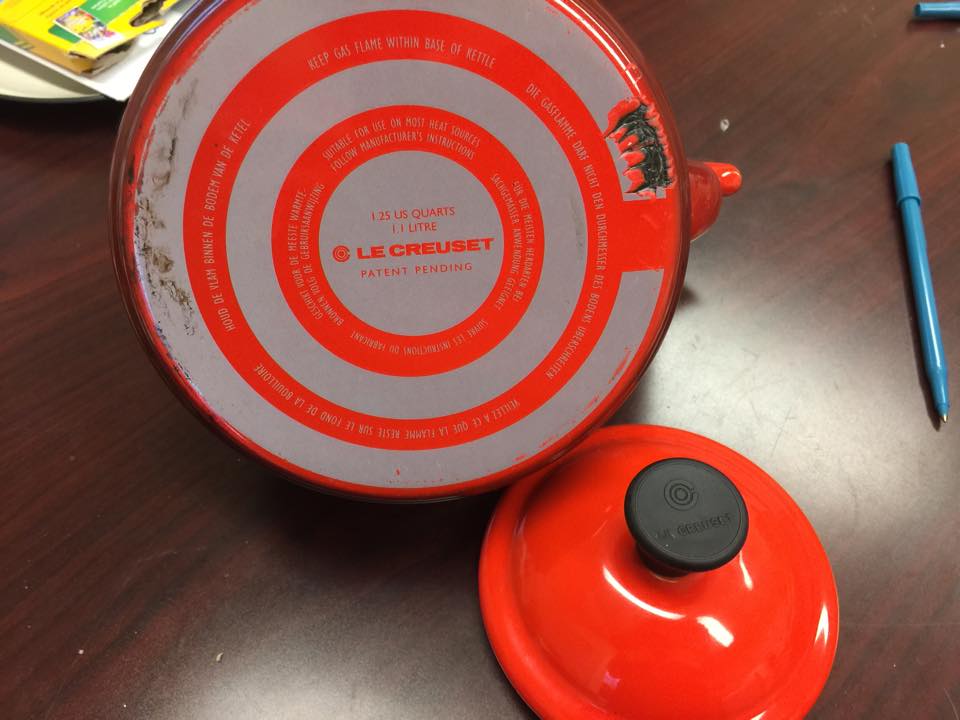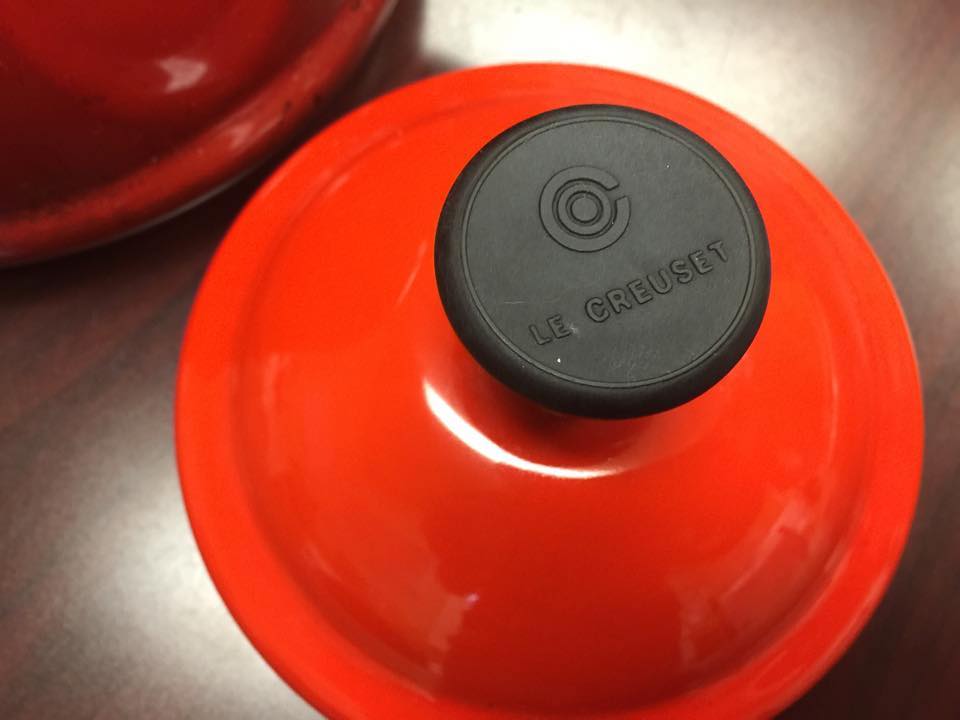The exterior enamel on this Le Creuset kettle was positive for 9,163 ppm Cadmium. Cadmium is a known carcinogen.
The exterior of this Le Creuset red enameled tea kettle was positive for 9,163 ppm Cadmium when tested with an XRF instrument.
It is not possible to test the interior surface of most of these kettles with an XRF instrument without destroying the kettle, because the instrument does not fit in the opening of the kettle.
The exterior was negative for Lead.
For context, in the U.S. – depending on which regulation you reference [the regulatory standards vary across the country – both the allowable limits for Cadmium and the testing methodologies used to determine those limits vary] the amount of Cadmium that is considered toxic in an item intended to be used by children is anything that exceeds the range of 40 to 75 ppm Cadmium. To read more on the variations state-to-state, check out THIS POST.
Loophole: Most cookware is not considered to be an “item intended for use by children” – even if children may eat the food prepared in this cookware.
The XRF instrument only determines the presence of a toxicant, it does not determine whether or not that toxicant will leach from the product during normal use.
Some of the regulatory limits for Cadmium rely solely on leach testing standards (not total content readings, as found with an XRF instrument.) As I understand these regulations, to determine compliance with the leach testing standards for Cadmium (and for Lead), in most cases manufacturers are NOT performing leach testing to exterior surfaces of cookware that may contain these toxicants. [Please correct me if you have information to the contrary.]
As a result it is possible that the exterior enamel, glaze or painted coating of a modern (or antique) cookware surface may be contaminating your kitchen environment yet the potential for this to be an toxicant exposure source has not been tested at all by any manufacturer, nor studied by any scientific or regulatory body.
The above concern has been just one of the foundations for my ongoing argument with the Ceramcor founder, who insisted he had done leach testing, but apparently had not done leach testing on the exterior of his pans (because it was not required). The exterior of his pans have a high-Lead component when tested with an XRF instrument and he claims that his pans are Lead-free.
As a result of all of the above considerations I am not confident that these high-level-toxicant-containing brightly colored exterior surfaces are being sufficiently tested to take into account the potential impact across multi-generational use and wear. This is especially a concern with brands like Le Creuset and Pyrex, where the products have been held onto and used for decades, and the older ones tend to show significant wear and chipping of the enameled, glazed or painted surfaces.
To learn more about XRF testing, Click HERE.
It’s really important to understand that no research has shown that products like this will poison the user. However, that does not mean having Cadmium in your kitchenware is a good idea. When you purchase items that are high in Cadmium (many red enamel or red glazed ceramic items fall in this category), you are supporting an industry (or a business – like Le Creuset) that has intentionally CHOSEN to use this toxicant as an ingredient in their manufacturing processes, in spite of the cost to human health and the planet — a cost that begins with impacts from the mining, refining and manufacturing of the Cadmium based red pigments.
It is for this reason that I believe there is no place for Cadmium in our kitchens (regardless of whether or not there is a proven health impact from use of the end product or not) and I have often considered formalizing a Le Creuset boycott of sorts (given both their newer and vintage items often test positive for either Lead or Cadmium at relatively high levels.)
To choose a toxicant-free tea kettle for your family, Click HERE.
Click HERE to read more about #CadmiumConcerns.
Thank you for reading and for sharing my posts.
As always, please let me know if you have any questions!
Never Miss an Important Article Again!
Join our Email List






What about other colors of tea kettles testing positive for cadmium or other poisonous substances? Caribbean? Deep Teal? Flame Orange? Marseille? Cobalt blue? Meringue (off white)? Any of the Purple colors? In the market for a new tea kettle & love Le Creuset so U have me concerned. Do ANY of the other colors test positive for lead or cadmium? Worried but love Le Creuset!!!
What about other colours? Eg le creuset’s satin black.
I just purchased about a hundred pieces of Moomin and Pippi Longstocking themed enamel ware for children (mugs, plates and bowls) that are produced in Sweden and Finland by Muurla. They are brand new and the Moomin distributor says they are safe for food service and made only of glass coated steel with decals fired onto the surface.I am quite freaked out by your website and now am fearful of giving these adorable items to my grandkids. What should I do?
That enamelware stuff is usually leaded – even “Made in Sweden”- so I would not be comfortable using it in the absence of independent testing.
Tamara